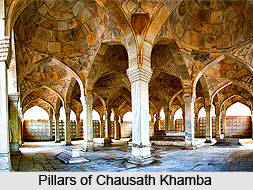 Chausath Khamba, also known as `Chaunsath Khamba` is an ancient tomb in the area of Nizamuddin, New Delhi which was constructed by Mirza Aziz Koka, the son of Ataga Khan, for himself during the period from 1623 to 1624. This mausoleum is based in the surroundings of the shrines of the Sufi saints which had been erected during the reign of the Mughal emperor Jahangir. Chausath Khamba implies `64 pillars` as per Hindi and Urdu language. Chausath Khamba is a portion of the complex of Nizamuddin and is proclaimed as a heritage building. The Aga Khan Trust had designed the Chausath Khamba. `Jashn-E-Khusrau`, a famous Sufi qawwali musical concert was held here in March 2010, in which performers from India as well as Pakistan has actively participated.
Chausath Khamba, also known as `Chaunsath Khamba` is an ancient tomb in the area of Nizamuddin, New Delhi which was constructed by Mirza Aziz Koka, the son of Ataga Khan, for himself during the period from 1623 to 1624. This mausoleum is based in the surroundings of the shrines of the Sufi saints which had been erected during the reign of the Mughal emperor Jahangir. Chausath Khamba implies `64 pillars` as per Hindi and Urdu language. Chausath Khamba is a portion of the complex of Nizamuddin and is proclaimed as a heritage building. The Aga Khan Trust had designed the Chausath Khamba. `Jashn-E-Khusrau`, a famous Sufi qawwali musical concert was held here in March 2010, in which performers from India as well as Pakistan has actively participated.
Architecture of Chausath Khamba
Initially, Chausath Khamba had been established as a special hall, in a unique eclectic architectural pattern of the Mughals, which was later transformed into a tomb. White marble has been employed to create this square-shaped structure which is equipped with 25 bays supported by 64 columns. A dome is supported by a bay. Marble trellised screens were fixed atop each of the five pilasters which hold the five arches. Located close to this mausoleum is present the tomb of Ataga Khan, who was the Prime Minister of Akbar. This monument contains numerable other tombs including the Ghalib tomb which is existent on its northern side. Mirza Aziz Koka was the Governor of Gujarat during the regime of Jahangir, and was first buried in tomb which was structurally similar to Chausath Khamba. However, much later his mortal remains were moved to Chausath Khamba.
Other Structures near Chausath Khamba
There exist two other historical monuments which are located near Chausath Khamba that have been declared as heritage monuments. The Urs Mahal is based in front of the Chausath Khamba and was the venue of various Qawwali music programmes during festive and social occasions. It was renovated in the year 2003. It served as an assembly hall. Situated to the north of Chausath Khamba is another tomb called Mirza Ghalib`s tomb, which contains the remains of the legendary Urdu poet named Mirza Ghalib and is an architectural beauty.



















